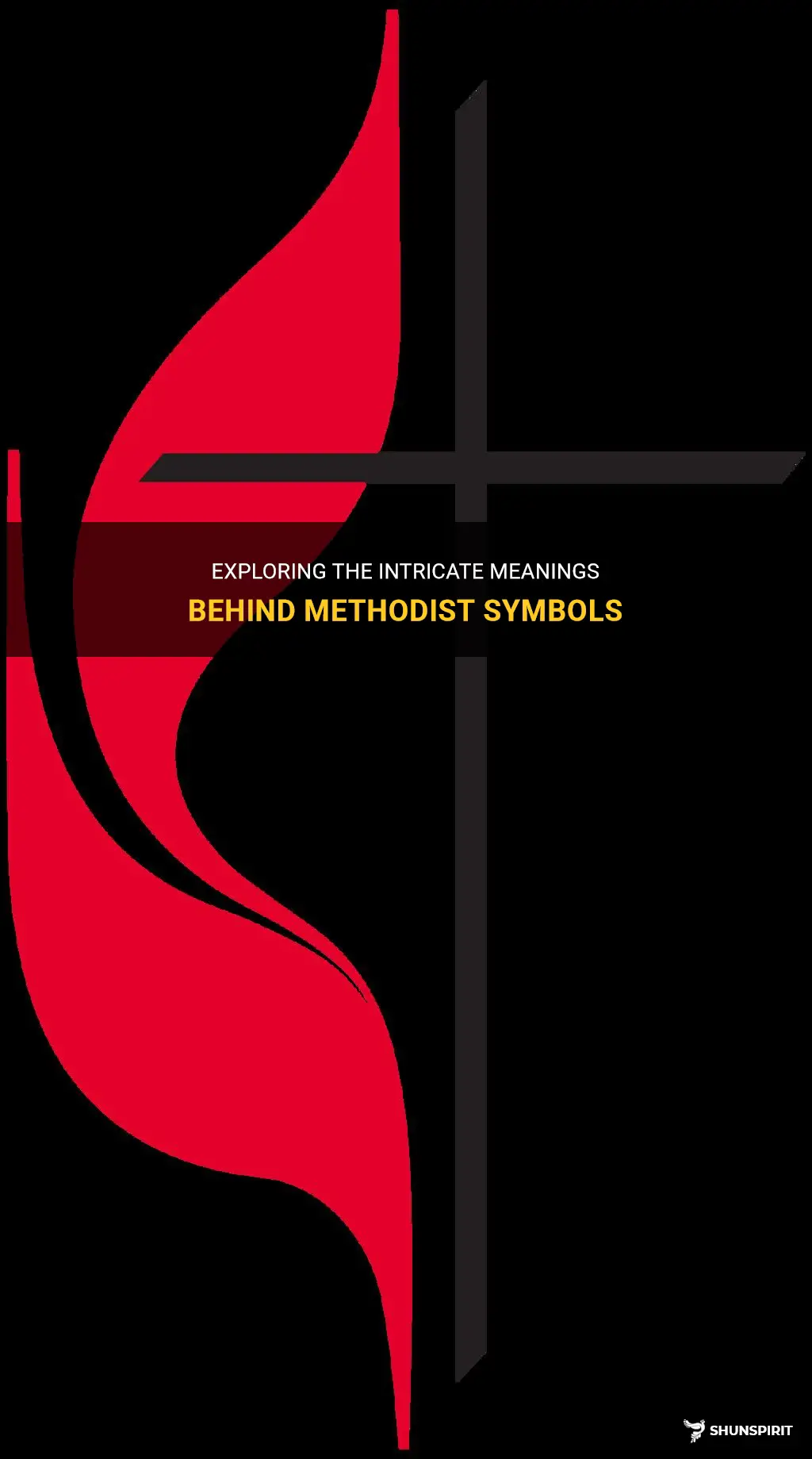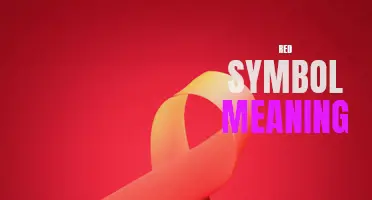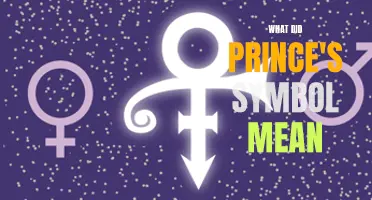
Methodist symbols and their meanings provide deeper understanding and connection to the Methodist faith. These symbols, which include the cross and flame, the trinity symbol, and the Wesleyan seal, serve as visual representations of key beliefs and principles. Each symbol holds significant meaning and serves as a reminder of the Methodist heritage, inspiring worshippers to live out their faith with passion and purpose. Whether displayed in churches, worn as jewelry, or used in worship, these symbols bring the Methodist faith to life and foster a sense of unity within the Methodist community.
What You'll Learn
- What are the main symbols used in Methodist churches and what do they represent?
- How do Methodist symbols differ from symbols used in other Christian denominations?
- What is the significance of the cross in Methodist theology and worship?
- Are there any specific colors or emblems associated with Methodism and if so, what do they signify?
- Are there any lesser-known symbols or meanings in Methodism that are not as widely recognized?

What are the main symbols used in Methodist churches and what do they represent?
Methodist churches, like most Christian denominations, have a variety of symbols that are used to represent their beliefs and practices. These symbols are often rich in meaning and serve as reminders of key aspects of the Methodist faith. Here are some of the main symbols used in Methodist churches and what they represent:
- Cross: The cross is the central symbol of Christianity and is widely used in Methodist churches. It represents the sacrifice of Jesus Christ and serves as a reminder of the central message of salvation through His death and resurrection.
- Flame: The flame is often associated with the Holy Spirit and is used as a symbol of divine presence and guidance. The flame represents the transformative power of the Holy Spirit and its role in inspiring and empowering believers.
- Fish: The fish symbol, also known as the Ichthys, was used by early Christians as a secret symbol of their faith during times of persecution. It is often used in Methodist churches as a reminder of the importance of living out one's faith in daily life.
- Dove: The dove is a symbol of peace and the Holy Spirit. It represents the presence of God and His peace that surpasses all understanding. The dove is often associated with baptism and serves as a reminder of the new life believers receive through the Holy Spirit.
- Water: Water is a prominent symbol in Methodist worship, particularly during baptism. It represents cleansing, renewal, and the washing away of sin. Water also symbolizes the abundant life that believers receive through their relationship with Christ.
- Bible: The Bible is central to Methodist belief and practice. It represents the Word of God and serves as a guide for faith and life. The Bible is often displayed prominently in Methodist churches as a reminder of the authority and importance of Scripture.
- Communion elements: The bread and wine, or grape juice, used during Holy Communion are symbols of the body and blood of Jesus Christ. They represent the sacrifice of Christ and the spiritual nourishment received through partaking in the sacrament. These elements are often displayed on an altar or communion table during worship.
- Crown: The crown is a symbol of victory and eternal life. It represents the hope and promise of salvation through Jesus Christ. The crown is often used to remind believers of their ultimate destination and the reward that awaits them in heaven.
These symbols are not meant to be worshipped or idolized but rather serve as visual reminders of key aspects of the Methodist faith. They help believers to focus their thoughts and intentions during worship and provide a visual representation of abstract theological concepts. They also serve as a means of connecting with the broader Christian tradition and the symbolism shared by believers around the world.
Decoding the Symbols on Your Instant Pot: What Do They Mean?
You may want to see also

How do Methodist symbols differ from symbols used in other Christian denominations?
Methodist symbols, like symbols used in other Christian denominations, have deep spiritual and historical significance. They serve as visual representations of important beliefs and values, reminding followers of their faith and guiding them in their spiritual journey. However, Methodist symbols also have distinct features that differentiate them from symbols used in other Christian denominations.
One of the distinctive aspects of Methodist symbols is the emphasis on the cross. The cross is a universal Christian symbol, representing the sacrifice of Jesus Christ and his victory over sin and death. In the Methodist tradition, the cross often appears as a plain and simple design, reflecting the humble and practical nature of Methodist faith. It serves as a reminder of the centrality of Christ's work on the cross and the call for believers to follow him in their daily lives.
In addition to the cross, the flame is another prominent symbol in Methodism. The flame represents the presence of the Holy Spirit, who guides and empowers believers in their spiritual journey. This flame is often depicted as a single flame or a cluster of flames, symbolizing the Wesleyan emphasis on personal experience of God's grace and the belief in the ongoing work of the Holy Spirit in the lives of believers.
Another unique symbol in Methodism is the "IHS" monogram. The letters "IHS" are derived from the Greek spelling of Jesus' name (ΙΗΣΟΥΣ). This symbol has been used for centuries in various Christian traditions, but it holds particular significance in Methodism. It is often associated with John Wesley, the founder of Methodism, who used this monogram as a personal symbol. The "IHS" monogram represents the person of Jesus Christ and serves as a reminder of the Methodist belief in salvation through faith in Christ alone.
Methodist symbols also include the use of colors. While colors are used in various Christian traditions, Methodism has its specific color symbolism. The color red, for example, represents the Holy Spirit and is often associated with Pentecost. It signifies the empowerment and anointing that believers receive from the Holy Spirit. On the other hand, the color white is used to symbolize purity, innocence, and holiness. It is commonly used during Easter and represents the resurrection of Jesus Christ and the hope of eternal life.
Overall, Methodist symbols share common elements with symbols used in other Christian denominations, such as the cross and the flame, which represent the central beliefs of Christianity. However, the specific use of the "IHS" monogram and the emphasis on colors in Methodism distinguish its symbols and help to convey the unique theological and practical aspects of the Methodist tradition. These symbols serve as reminders of Methodist beliefs and values and guide believers in their journey of faith.
Exploring the Intricate Symbolism and Meaning behind BDSM Symbols
You may want to see also

What is the significance of the cross in Methodist theology and worship?
The cross holds significant meaning in Methodist theology and worship. Methodists believe that the cross is a symbol of God's love and redemption. It serves as a reminder of Jesus Christ's sacrifice and the hope of salvation.
In Methodist theology, the cross is the central aspect of Jesus' mission on Earth. Methodists view the cross as a representation of God's ultimate act of love and forgiveness. It is seen as a sign of God's grace and mercy, as Jesus willingly gave his life on the cross to save humanity from sin and reconcile them with God.
In worship, the cross is prominently displayed in Methodist churches. It serves as a visual reminder of Christ's sacrifice and the foundation of the faith. The cross is often adorned with flowers or drapes during special occasions such as Easter and Christmas, signifying the joy and celebration of Jesus' resurrection.
Methodists also incorporate the cross into their liturgical practices. It is common for Methodists to make the sign of the cross during prayers and rituals, as a way of consecrating themselves and acknowledging their faith in Jesus Christ. The cross is also frequently included in Methodist hymns and prayers, as a symbol of hope and salvation.
The cross is not only a symbol of Christ's sacrifice but also a call to discipleship and service. Methodists believe that just as Jesus carried his cross, they too have a responsibility to carry their own crosses in life. This means being willing to sacrifice, serving others, and following the example set by Jesus.
Furthermore, the cross serves as a reminder of the wider Methodist tradition. Methodism traces its roots back to the 18th-century revival led by John Wesley. Wesley's emphasis on the cross and its significance in the Christian faith has been carried forward by subsequent generations of Methodists. The cross continues to be a unifying symbol for Methodists worldwide, connecting them to their shared history and theological heritage.
In conclusion, the cross holds great significance in Methodist theology and worship. It represents God's love, redemption, and sacrifice. The cross serves as a visual reminder of Jesus' mission on Earth and the hope of salvation. It is a symbol of faith, discipleship, and the wider Methodist tradition. Through the cross, Methodists find meaning, hope, and inspiration for their journey of faith.
Decoding the Symbolic Meaning Behind The Gift on Netflix
You may want to see also

Are there any specific colors or emblems associated with Methodism and if so, what do they signify?
Methodism is a Christian denomination that has a rich history and a distinct identity. While there are no specific colors or emblems that are universally recognized as being associated with Methodism, there are some colors and symbols that have been traditionally used by Methodist churches and organizations.
One of the colors commonly associated with Methodism is red. Red is often used to symbolize the Holy Spirit and the fire of passion and commitment to God. In Methodist liturgical practices, red is often used during Pentecost and other celebrations that focus on the work of the Holy Spirit.
Another color that is often associated with Methodism is blue. Blue represents the Virgin Mary and is associated with her role as the mother of Jesus. Blue is also a color that is often associated with peace and tranquility, and it is often used during Advent and other times of contemplation and reflection.
In addition to these colors, there are several symbols that are commonly associated with Methodism. One of the most well-known symbols is the cross and flame. This symbol features a cross with a flame-shaped design extending from the center. The color red is often used for the flame, representing the Holy Spirit, while the color gold or yellow is used for the cross, symbolizing the sanctification of the believers.
The cross and flame symbol was adopted as the official logo of the United Methodist Church in 1968, but it has been used by Methodist organizations and churches for decades prior to that. The symbol represents the merging of two Methodist denominations, the Methodist Church and the Evangelical United Brethren Church, and it is a visible representation of the Methodist commitment to the Wesleyan tradition.
The symbol of the cross and flame can be seen on Methodist churches, publications, and other materials, serving as a visual reminder of the Methodist faith and its core values.
While there are no universal colors or emblems that are exclusively associated with Methodism, the use of red and blue in liturgical practices and the presence of the cross and flame symbol are common elements that connect Methodist churches and organizations. These visual representations serve to remind Methodists of their faith and the values they hold dear, and they provide a sense of identity and unity within the Methodist community.
Deciphering the Symbolism of the Heart with Wings: What Does it Really Mean?
You may want to see also

Are there any lesser-known symbols or meanings in Methodism that are not as widely recognized?
Methodism is a Christian denomination that has a rich history and many symbols that hold important meanings. While some of these symbols, such as the cross and the flame, are well-known and recognized by many, there are also some lesser-known symbols and meanings in Methodism that may not be as widely recognized. In this article, we will explore some of these lesser-known symbols and their meanings.
One lesser-known symbol in Methodism is the quadrilateral. The quadrilateral is a symbol that represents the four sources of authority in the faith: scripture, tradition, reason, and experience. This symbol is often used to highlight the importance of balancing these four sources when interpreting scripture and making decisions in the church. The quadrilateral serves as a reminder that Methodists believe in a holistic approach to understanding and living out their faith.
Another lesser-known symbol in Methodism is the covenant. The concept of covenant holds great significance in Methodist theology. It refers to the special relationship that exists between God and his people. In Methodism, covenants are seen as sacred agreements that guide and shape the life of the church. The most well-known covenant in Methodism is the Wesleyan Covenant, which is a commitment to live out one's faith in works of piety and mercy. This covenant is often renewed by Methodists during special services, such as covenant renewal services.
The chalice is another symbol that holds a lesser-known meaning in Methodism. The chalice, or cup, is often used in communion services to represent the blood of Christ shed for the forgiveness of sins. In Methodism, the chalice is also associated with John Wesley, the founder of Methodism. According to tradition, Wesley would often carry a small communion set with him and would use it to administer the sacrament wherever he went. This image of Wesley with the chalice symbolizes his deep commitment to the sacramental life of the church.
The flame is a symbol that is commonly associated with Methodism, but there may be some lesser-known meanings behind it. The flame represents the Holy Spirit and is often used to symbolize the presence and work of the Spirit in the life of the church. In Methodism, the flame is often depicted as a single flame divided into three parts, representing the three persons of the Trinity: God the Father, God the Son (Jesus Christ), and God the Holy Spirit. The flame is a reminder of the power and presence of God in the midst of the Methodist community.
While the cross is a well-known symbol in Christianity, it also holds a specific meaning in Methodism. The Methodist cross is often known as the "Methodist flame cross" or the "United Methodist Church cross and flame." The cross represents the crucifixion and resurrection of Jesus Christ, while the flame represents the Holy Spirit. Together, the cross and flame symbolize the essential aspects of Methodist faith, including the salvation offered through Christ's sacrifice and the empowering presence of the Spirit.
In conclusion, Methodism has many symbols that hold important meanings. While some symbols, such as the cross and the flame, are widely recognized, there are also some lesser-known symbols and meanings in Methodism. These symbols, such as the quadrilateral, the chalice, and the covenant, hold significant meanings and serve as reminders of the Methodist faith and the teachings of John Wesley. By understanding and appreciating these symbols, Methodists can deepen their connection to their faith and the Methodist tradition.
Understanding the Meaning Behind Dehumidifier Symbols: A Handy Guide
You may want to see also
Frequently asked questions
The symbol of the Methodist Church is the cross and flame. The cross represents the central focus of the Christian faith, while the flame represents the Holy Spirit and the mission of the church.
The flame in the Methodist symbol represents the Holy Spirit. It symbolizes the presence and power of the Spirit in the life of the church and its members. It also represents the mission of the church to spread the light of the Gospel to the world.
The cross in the Methodist symbol represents the central focus of the Christian faith, which is the sacrificial death and resurrection of Jesus Christ. It serves as a reminder of God's love and grace, and symbolizes the forgiveness of sins and eternal life that Christians receive through faith in Jesus.
In addition to the cross and flame, there are several other symbols that are commonly associated with Methodism. These include the Wesleyan quadrilateral (representing the four sources of authority in Methodist theology), the open Bible (symbolizing the importance of Scripture in Methodist belief), and the hymn book (representing the rich tradition of Wesleyan hymnody).
The Methodist symbols are significant because they serve as visual reminders of the core beliefs and values of the Methodist Church. They help to identify Methodist churches and organizations, and provide a sense of unity and identity among Methodists worldwide. The symbols also serve as teaching tools, helping to convey important aspects of Methodist theology and spirituality to both members and non-members.







